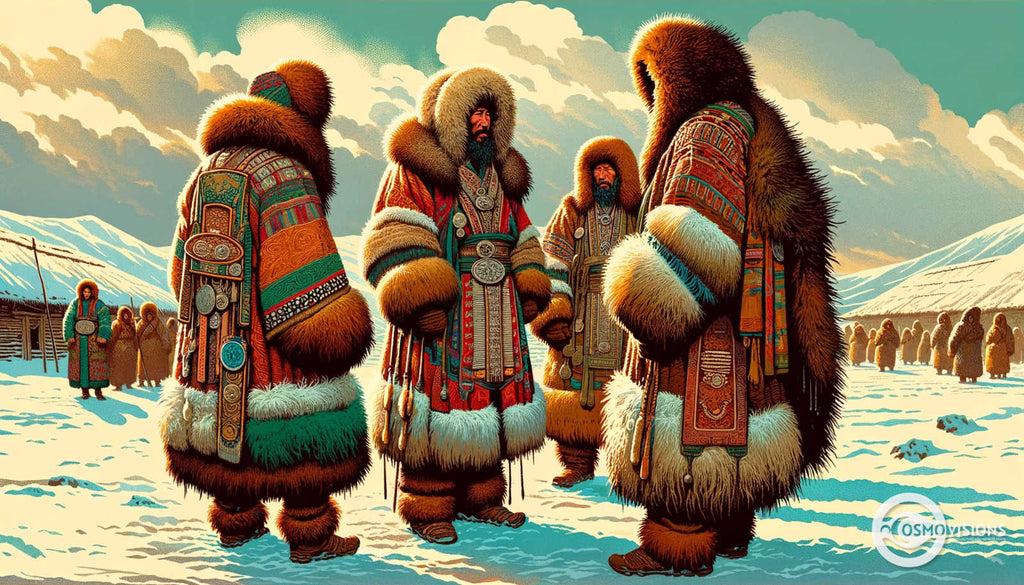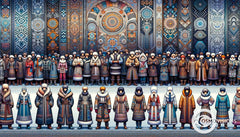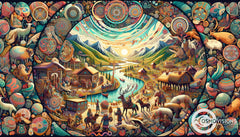Yakut Clothes of the 17th and 18th Centuries: A Journey Through Time and Tradition
Posted by Massimiliano Geraci

Overview of the French Archaeological Missions in Yakutia
For over 15 years, French archaeological missions, in collaboration with Yakut archaeologists, have unearthed tombs in Yakutia. This intercultural effort has shed light on the genesis of settlement and the man/environment interactions in this region. The focus on clothing from these excavations offers a unique lens into Yakut history and culture. Thanks to the permafrost, a treasure trove of well-preserved garments has been discovered, providing an authentic look into the past far beyond the sometimes fanciful designs documented by travelers in previous centuries.
Importance of Clothing in Understanding Yakut History and Culture
Clothing in Yakutia, preserved by the unique permafrost conditions, offers more than just aesthetic insight. It represents a complex interplay of social status, cultural identity, and historical evolution. The detailed documentation and careful restoration of these garments have allowed us to peek into the rich tapestry of Yakut life, where clothing was a significant marker of individual socialization and a canvas for displaying wealth and status.
Material and Methods
Field Survey and Laboratory Analysis
A collaborative approach has been pivotal, combining the expertise of archaeologists, anthropologists, and Yakut material culture specialists. The process involved a meticulous autopsy of the clothing layers, clearing, and documentation, followed by laboratory analysis. This multi-disciplinary approach has enabled a holistic understanding of the clothing, considering the physical aspects and cultural and historical contexts.
Clothing Restitution
The restitution of Yakut clothing used innovative techniques to recreate the garments accurately. By studying coats, dresses, and shirts from the 17th to 19th centuries, researchers could reconstruct not just the clothing but also a part of Yakut's history. This meticulous work involved piecing together the layers of clothing, often using watercolor illustrations to differentiate the layers and detailed sketches to understand the manufacturing and sewing techniques.

The Men’s Clothing Evolution
17th Century Styles
In the 17th century, men's clothing in Yakutia predominantly featured fur and skin, symbolizing adaptation to the harsh climatic conditions. The ample fur coats, often with outward hair, allowed ease of movement, essential in the Yakut lifestyle. These garments sometimes included metallic elements, indicating the wearer's status and craftsmanship skills.
Transition in the 18th Century
The 18th century saw a significant shift in Yakut men's clothing with the introduction of European-manufactured goods. Silk from China, woolens from Russia and England, and cotton began to make their way into traditional Yakut attire. This transition represented a change in materials and a cultural shift, reflecting increased trade interactions and the influence of foreign fashion, especially from Russian noble circles.

The Men’s Clothing Evolution in Yakutia: A Reflection of Cultural and Economic Shifts
17th Century Styles: A Harmony of Fur and Skin
The 17th century in Yakutia was marked by the predominant use of animal fur and skin in men's clothing, a testament to the region's harsh climatic conditions. The clothing of this era was not merely functional but also a symbol of one's social status and identity. The Yakut men adorned themselves in ample fur coats, typically with the fur facing outward, designed for ease of movement essential in the nomadic lifestyle. These coats were sometimes embellished with metallic elements such as copper alloy or low-grade silver, indicative of local craftsmanship and the wearer’s social standing.
The materials used for these garments mainly included horse and reindeer fur, reflecting the indigenous resources. The coats were often doubled with fur, adding a layer of warmth and luxury. The presence of metallic decorations in these garments, albeit sparse, marks the beginning of external influences on Yakut clothing.
Transition in the 18th Century: European Influences and Material Shifts
The 18th century ushered in significant changes in Yakut men's clothing, predominantly influenced by the influx of European-manufactured goods; this period marked a gradual transition from traditional fur and skins to silk, woolens, and cotton, reflecting an increasing interaction with European traders and a shift in socio-economic conditions.
Introduction of European-manufactured Goods
The 18th century saw the incorporation of various European-manufactured goods into Yakut attire. This included glass beads, rare copper tokens bearing effigies of European monarchs, and fabrics such as silk from China and woolens from Russia and England. This blend of local and foreign materials signified a change in aesthetic preferences and mirrored the Yakut society's increasing exposure to and interaction with external cultures.
Shift Towards Silk, Woollens, and Cottons
With the introduction of these new materials, there was a noticeable shift in the textiles used for clothing. Silk became a popular choice for shirts, allowing the wealthier segments of society to display their affluence. Woollen and cotton fabrics, introduced through trade, gradually became more prevalent in everyday clothing. This shift was not just a matter of fashion but also represented a cultural assimilation of foreign influences, blending them with traditional designs.
Evolution in Design and Style
The design and style of men's clothing also evolved during this period. The traditional, expansive fur coats started to be replaced by more fitted garments, reflecting European fashion influences. These changes included waisted cuttings, asymmetric median cuts, and Redingote-like fitted coats, which were more adjusted to the waist and flared downwards. However, the traditional elements like puffed sleeves and fur edges were retained, symbolizing a fusion of old and new.
Symbolism and Social Significance
The 18th-century clothing evolution in Yakutia was about changing fashion trends and the symbolism and social significance embedded in these garments. Clothing became more than a necessity or status symbol; it became a canvas displaying the wearer's wealth, social status, and cultural connections. This period it marked a significant phase in the Yakut clothing tradition, setting the stage for further evolution and innovation in the following centuries.
The Women’s Clothing Transformation in Yakutia: A Tale of Cultural Synthesis and Style Evolution
Early 18th Century Styles: Emergence of Imported Influences
Archaeological findings from Yakutia in the early 18th century provide scarce evidence of women's clothing. This period marks a transitional phase in the fashion history of Yakutia, where traditional clothing began to incorporate elements reflecting increased trade and cultural interactions.
Use of Imported Goods in Female Garments
The limited garments discovered from this era indicate a significant use of imported materials in women's attire. Silk, glass beads, and woolen fabrics appeared in female garments, suggesting a shift towards more diverse material choices. This incorporation of foreign elements highlighted a gradual movement from solely utilitarian clothing to a more stylistic and status-driven approach.
Late 18th Century Trends: Diversification and Foreign Influence
Four Types of Traditional Clothes Identified
By the late 18th century, a clearer picture of Yakut women's clothing emerged, with four distinct types of traditional attire identified. These include various dresses and coats, each with unique features and designs, showcasing the rich tapestry of Yakut fashion.
Influence of Foreign Fashion Elements
The latter part of the 18th century saw a profound influence of foreign fashion elements in Yakut clothing. The introduction of European styles, alongside the continued use of traditional Yakut motifs, resulted in a unique blend of local and foreign fashion sensibilities. This period reflects a significant cultural synthesis, with Yakut women's clothing embodying a mix of traditional Yakut craftsmanship and external fashion influences.
Weaving Threads of Time: The Story of Yakut Clothing
Reflecting History: Yakut Clothing and Historical Literature
The traditional Yakut clothing from the 17th and 18th centuries offers a unique insight into the historical and social evolution of the region. Comparisons with historical literature reveal that these garments represent more than mere attire; they are a testament to the cultural adaptation and interaction with external influences. The ostentatious use of imported materials in clothing, such as silk, glass beads, and European-manufactured goods, especially from the mid-18th century, suggests a society reveling in its wealth and status. This contrasts sharply with the earlier periods, where practicality and adaptation to harsh climates were paramount.
Symbolism and Social Fabric: The Role of Clothing in Yakut Culture
Yakut clothing of these eras was not just a protection against the severe cold but a canvas displaying social status and identity. The incorporation of metallic elements, the transition to more luxurious materials like silk and woolen fabric in men's clothing, and the use of imported goods in women's attire signified a society in transition. Clothing became a way to express individual and group identity, showcasing wealth, social status, and cultural connections.
Unraveling the Future: Research Prospects in Yakut Clothing
Future research on Yakut clothing promises to delve deeper into understanding the society's structure, cultural evolution, and interactions with other cultures. Key areas of interest include the role of clothing in Yakut funeral practices and its symbolism in marking social status and identity. Further ethnological data are required to decode the symbolic aspects of these garments fully. Unanswered questions about the production, distribution, and evolution of these clothes also remain, pointing toward a rich field of study for historians and anthropologists.





















